Entecavir Patent Evaluation, Method for Diastereomeric Impurities
Krishna Sarma Pathy*
Head –QC,QA/R&D-IPL Research Centre Lucknow, India
Submission: June 01, 2018; Published: June 26, 2018
*Corresponding author: Krishna Sarma Pathy, Head –QC,QA/R&D-IPL Research Centre Lucknow, India, Tel: 7080981238; Email: drkrishnasarmapathy@yahoo.in
How to cite this article: Krishna S P. Entecavir Patent Evaluation, Method for Diastereomeric Impurities. Organic & Medicinal Chem IJ. 2018; 7(3): 555711. DOI: 10.19080/OMCIJ.2018.07.555711
Abstract
Entecavir is an oral antiviral drug used in the treatment of hepatitis B infection. Entecavir is a guanosine nucleoside analogue with selective activity against hepatitis B virus (HBV), which inhibits reverse transcription, The initial patent on entecavir expired in South Africa in 2011 ZA 1991/07894. Current status available on: http://patentsearch.cipc.co.za/, which should have permitted lower-cost generic competitors to enter the market. However, South Africa granted BMS three additional patents on entecavir that only expire between 2022 and 2026. Two of these patents have lapsed-meaning BMS has not paid the renewal fees, and they cannot be enforced-while one patent covering a lower dosage form of entecavir remains in force. This patent is currently under litigation in India Basheer S. BMS Hepatitis Patent Invalidated: A Viral Effect for India? http://spicyip.com/2013/02/bms-hepatitis-patent-invalidated-viral.html, but because it is in force in South Africa, generic suppliers may be discouraged from bringing their low-dose products to market. A more recent patent on entecavir has not yet been received or processed by the Patents Office, but it could be filed up until the end of 2014Patent number: WO/2013/177672. Current status available on pa-tentscope.wipo.int. This patent covers the manufacturing process of entecavir, and is an example of patent ever greening-where companies file patents on minor changes to an existing drug to maintain patent protection and block competition. The same patent was recently overturned in the United States for failing to meet the criteria of inventive step.
However, in South Africa, since no examination of patent applications occurs, if the patent is filed, it is likely to be granted to BMS. So long as BMS maintains a monopoly on entecavir in South Africa, the price is likely to remain high, and entecavir will remain out of reach for those who need it. But the crystalline forms of entecavir and its performances are not researched and reported in the above-mentioned patent. The review relates to analogues of 2′-cyclopentyl deoxyguanosine, especially relates to entecavir, its preparation and the pharmaceutical composition and uses thereof. This method was capable to detect Entecavir and its diastereomeric impurities at a level below 0.009% with respect to test concentration of 500 μg ml-1 for a 20 μL injection volume. The method has shown good, consistent recoveries for diastereomeric impurities (95-105%). The test solution was found to be stable in the diluent for 48 h. The drug was subjected to stress conditions. The mass balance was found close to 99.5%.Entecavir also helps to prevent the hepatitis B virus from multiplying and infecting new liver cells, is also indicated for the treatment of chronic hepatitis B in adults with HIV/AIDS infection.
Method Details: C18 stationary phase (150 x 4.6 mm, 3.5 microns particles) with the economical and simple mobile phase combination delivered in an isocratic mode at a flow rate of 1.0 ml min-1 at 254 nm. In the developed method, the resolution between Entecavir and its diastereomeric impurities was found to be greater than 2.0. Regression analysis shows an r2 value (correlation coefficient) greater than 0.999 for Entecavir and for its diastereomeric impurities.
Introduction
The chemical name for entecavir is 2-amino-I, 9-dihydro-9-[(1S,3R,4S)-4-hydroxy-3-(hydroxymethyl)-2-methylenecyclopentyl)-6H-purin-6-one, monohydrate. Its molecular formula is C12H15N5O3.H2O, which corresponds to a molecular weight of 295.3. Entecavir, BMS-200475, SQ-34676(1S,3R,4S)-9-[4-Hydroxy-3-(hydroxymethyl)-2-methylenecyclopentyl] guanine
CAS-42217-69-4, 209216-23-9 (monohydrate) (Figure 1).
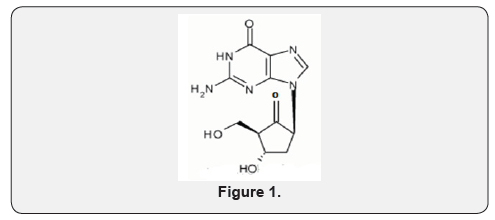
Anti-Hepatitis Virus Drugs, ANTIINFECTIVE THERAPY, Antiviral Drugs -Phase III
Discussion
Entecavir exhibits much times stronger effects than Lamivudine in experiments such as antiviral activities, resistances, cross resistances and the like.Many methods of preparing for entecavir compounds and a method for obtaining a little entecavir solid separated by resin column chromatography are described in U.S. Pat. No. 5,206,244 and WO98/0994. The method of preparing for non-crystalline forms of entecavir is disclosed in Chinese Patent Publication No. CN1660846A. Several methods have been developed for the determination of Entecavir and its enantiomers by HPLC, LCMS techniques [1-12]. Entecavir is an oral antiviral drug used in the treatment of hepatitis B virus (HBV) infection. Entecavir is a reverse transcriptase inhibitor. It prevents the hepatitis B virus from multiplying and reduces the amount of virus in the body. More specifically, it is a deoxyguanosine analogue that inhibits reverse transcription, DNA replication and transcription in the viral replication process. Entecavir belonging to the chemical class of purine derivatives and chemically it is 2-amino-9-[(1S, 3R, 4S)-4-hydroxy-3-(hydroxymethyl)-2-methylidenecyclopentyl] - 3H-purin-6-one with molecular formula C12H15N5O3. Entecavir is a white to off-white powder. It is slightly soluble in water (2.4 mg/mL), and the pH of the saturated solution in water is 7.9 at 25°C ± 0.5°C. Baraclude film-coated tablets are available for oral administration in strengths of 0.5 mg and 1 mg of Entecavir.
The methods of [1-2] describes about the determination of Entecavir in tablet dosage form by LC. The LC method of [3- 4] defines about the estimation of Entecavir in bulk as well as pharmaceutical dosage forms. The method of [5-7] explains about the determination of Entecavir using LC-MS techniques in drugs and plasma. The method of [8-9] clarifies the determination of Entecavir by spectrophotometric procedure. The approaches of [10] states that the optical isomer of Entecavir through enantiospecific HPLC. The tactics of [11] enlightens the determination of related compounds of Entecavir by LC. The method of [12] instructs about the determination of Entecavir by voltammetry in formulated dosage forms.
This research article describes a simple, sensitive and cost effective mobile phase method for determination/quantitation of diastereomeric impurities of Entecavir in drug substances as well as in drug products. Comparison of different techniques listed in Table 1. The work also includes the method development and the complete validation [13] as per ICH guidelines. Hitherto; there is no article for the quantification and determination of diastereomeric impurities of Entecavir in drug substances and drug products. This is a novel and sensitive method for the diastereomeric impurities in Entecavir using HPLC (Figure 2).
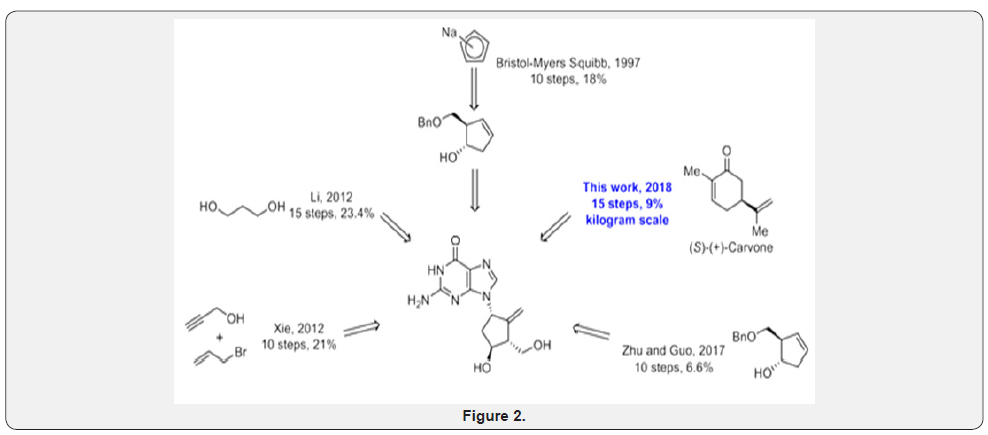

Patent Information
Bristol-Myers Squibb was the original patent holder for Baraclude, the brand name of entecavir in the US and Canada. The drug patent expiration for Baraclude was in 2015. On August 26, 2014, Teva Pharmaceuticals USA gained FDA approval for generic equivalents of Baraclude 0.5 mg and 1 mg tablets; Hetero Labs received such approval on August 21, 2015; and Aurobindo Pharma on August 26, 2015.
Chronic hepatitis B virus infection is one of the most severe liver diseases in morbidity and death rate in the worldwide range. At present, pharmaceuticals for treating chronic hepatitis B (CHB) virus infection are classified to interferon α and nucleoside/ nucleotide analogue, i.e. Lamivudine and Adefovir. However, these pharmaceuticals cannot meet needs for doctors and patients in treating chronic hepatitis B virus infection because of their respective limitation. Entecavir (ETV) is referred to as 2′-cyclopentyl deoxyguanosine (BMS2000475) which belongs to analogues of Guanine nucleotide and is phosphorylated to form an active triple phosphate in vivo. The triple phosphate of entecavir inhibits HBV polymerase by competition with 2′-deoxyguanosine-5′-triphosphate as a nature substrate of HBV polymerase, so as to achieve the purpose of effectively treating chronic hepatitis B virus infection and have strong anti-HBV effects. Entecavir, [1S-(1α,3α,4β)]-2-amino-1,9-dihydro-9-[4- hydroxy-3-hydroxymethyl]-2-methylenecyclopentyl]-6H-purin-6- one, monohydrate, and has the molecular formula of C12H15N5O3. H2O and the molecular weight of 295.3. Its structural formula is as follows
Entecavir was successfully developed by Bristol-Myers Squibb Co. of USA first and the trademark of the product formulation is Baraclude™, including two types of formulations of tablet and oral solution having 0.5 mg and 1 mg of dosage. Chinese publication No. CN1310999 made by COLONNO, Richard, J discloses a low amount of entecavir and uses of the composition containing entecavir in combination with other pharmaceutically active substances for treating hepatitis B virus infection; however, the entecavir is non-crystal. In addition, its oral formulations such as tablet and capsule are made by a boiling granulating process. The process is too complicated to control quality of products during humidity heat treatment even though ensuring uniform distribution of the active ingredients (Figure 3).
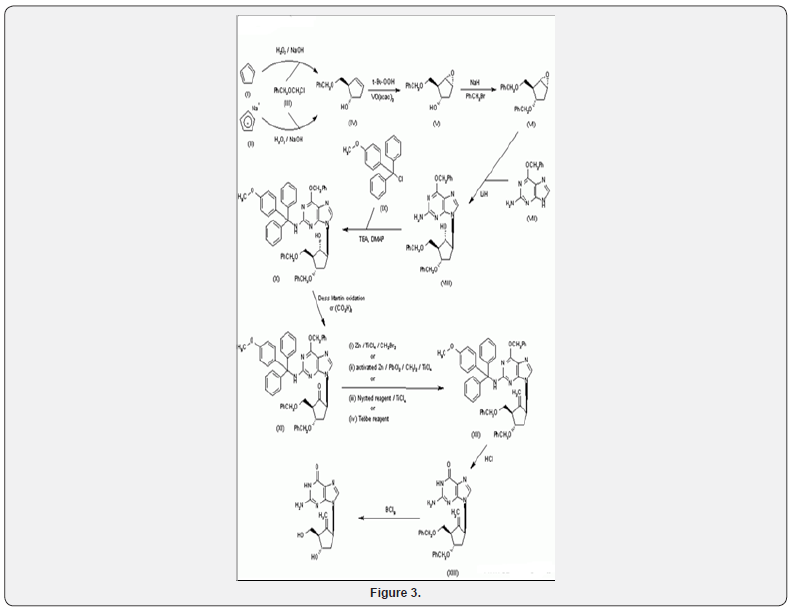
Synthesis of BMS-200475 (EN: 182634) The region selective reaction of cyclopentadiene (I) and sodium (1) or commercial sodium cyclopentadienide (II) (2,3) with benzyl chloromethyl ether (III) by means of the chiral catalyst (-)-diisopinocampheylborane in THF, followed by hydroxylation with H2O2/NaOH, gives (1S-trans)-2-(benzyloxymethyl)-3-cyclopenten-1-ol (IV), which is regioselectively epoxidized with tert-butyl hydroperoxide and vanadyl acetylacetonate in 2,2,4-trimethylpentane, yielding [1S-(1alpha,2alpha,3beta,5alpha)-2-(benzyloxymethyl)-6- oxabicyclo[3.1.0]hexan-3-ol (V). The protection of (V) with benzyl bromide and NaH affords the corresponding ether (VI), which is condensed with 6-O-benzylguanine (VII) by means of LiH in DMF to give the guanine derivative (VIII). The protection of the amino group of (VIII) with 4-methoxyphenyl(diphenyl)chloromethane (IX), TEA and DMAP in dichloromethane gives intermediate (X), which is oxidized at the free hydroxyl group with methylphosphonic acid, DCC and oxalic acid in DMSO (1) or Dess Martin periodinane in dichloromethane (2, 3), yielding the cyclopentanone derivative (XI). The reaction of (XI) with (i) Zn/TiCl4/CH2Br2 complex in THF/CH2Cl2 (1), (ii) activated Zn/PbCl2/CH2I2/TiCl4 in THF/ CH2Cl2 (2), (iii) Nysted reagent/TiCl4 in THF/CH2Cl2 (2, 3) or (iv) Tebbe reagent in toluene (2) affords the corresponding methylene derivative (XII), which is partially deprotected with 3N HCl in hot THF, providing the dibenzylated compound (XI). Finally, this compound is treated with BCl3 in dichloromethane (1-3). (Scheme 18263401a) Description Hydrate, m.p. >220 C, alpha (22,D) +34?(c 0.3, water) (1); monohydrate, white crystalline solid, m.p. 234-6 C (decomp.) for the bulk sample and m.p. 255 C (decomp.) for an analytical sample recrystallized from water, alpha(D) +33.2?(c 0.3, water) (2); alpha(D) +35.0?(c 0.38, water) (3). Manufacturer Bristol-Myers Squibb Co (US).
The Reaction Steps
Preparation 1: Prepared with a short fractionating column (filler may be added) the atmospheric distillation unit, the receiving flask was added anhydrous calcium chloride, and placed in an ice-water bath polymerization (monomer cyclopentadiene rt shall cryopreservation) and tail have to take over the drying tower. Dicyclopentadiene was added to the three-neck flask, the system micro nitrogen, warmed slowly with stirring to 180 °C, holding the distillation gas inlet temperature does not exceed 42 °C, to give a final monomer cyclopentadiene (cryopreservation). Preparation 2 was added to the kettle in dry xylene, sodium metal to surface oxidation, micro nitrogen, warmed to and stirred at 120~150 °C, the sodium was dissolved, with vigorous stirring, sodium dispersed into sodium sand, stirring was stopped, the system was returned to room temperature, sodium sand cured, removing surface xylene, replacement with a suitable amount of anhydrous THF three times, finally dry THF was added protection, backup. In the micro nitrogen, tetrahydrofuran ice-water bath - Sodium sand cooling 0~10 °C, the prepared cyclopentadiene monomer was slowly added dropwise to a tetrahydrofuran - sodium sand system, control the temperature not exceeding 10 °C, After the dropwise addition, the ice-water bath was removed, allowed to warm to rt naturally and stirred for about 3 hours, and sediment sodium is consumed, to give a final solution of sodium cyclopentadiene reddish. Preparation 3: The dimethylphenyl chlorosilane and anhydrous tetrahydrofuran were added to the reaction kettle, micro under N2, and the system was cooled to -70 °C or less, dropwise addition of 2, was added dropwise to control the temperature - below 70 °C, addition was complete the mixture was stirred at -70 °C or less incubated for about 3 hours, TLC the reaction was complete was naturally warmed to 0 °C, was slowly added to ice water, stirred, allowed to stand, and the organic phase , washed with saturated sodium bicarbonate solution and extracted with n-hexane with dried over anhydrous sodium sulfate, and concentrated under reduced pressure at 65 °C, the final 3 to give a dark yellow oil. Preparation 4: 3 and the reactor was added n-hexane cooled to -10 °C, quickly dichloroacetyl chloride drop wise wherein continued stirring, triethylamine and a mixture of n-hexane was slowly added to the system drop wise, the temperature was kept at -5 °C or less, addition was complete, the reaction at 0~4 °C for about 4 hours, then warmed to room temperature naturally 8~10 hours (overnight). Completion of the reaction by TLC. Water was added, stirred for 30 minutes at room temperature, standing layer, extracted with hexane, the organic layers were combined, washed to neutrality with saturated sodium bicarbonate, saturated brine, dried over anhydrous sodium sulfate, filtered and the filtrate was concentrated under reduced pressure to give 4 dark oil. Prepared at room temperature for 4 to 5, methanol, water and triethylamine were added to the reaction vessel, stir. Warmed to 75-80 °C, the reaction 4~5 hours, the reaction was complete, the system was cooled to below 10 °C, potassium carbonate was added, stirred for 30 minutes, was slowly added sodium borohydride (note the paste), slowly raised It was stirred at room temperature for 8-10 hours to complete the reaction. At this time, the reaction system PH = 9-10. Water was added to the system and quench the reaction, stirred for 0.5 hours, the system was adjusted with concentrated hydrochloric acid to PH = 2-3, and extracted with ethylacetate, the organic phase was separated, washed with saturated brine, and the combined organic phases are dried over anhydrous sodium sulfate, filtered, and concentrated to give a viscous black 5. Preparation 6: 5, respectively, and absolute ethanol was added L-amino purified autoclave, stirring chamber for about 1 hour, the crystal precipitation temperature was raised to 50-60°C, stirred for 5-6 hours, cooled to room temperature stirred for about 3 hours, filtered, the filter cake was washed with small amount of absolute ethanol, the filter cake was dried under reduced pressure at 55°C for 10 hours to give 5 as a light brown powdery solid (HPLC San 93%). Preparation 7: addition of methanol at room temperature and at 6, to ice-salt bath and dry reaction vessel, was added dropwise concentrated sulfuric acid, controlling the temperature below 5°C. After the addition, naturally warmed to room temperature (about 20-30°C), reaction was stirred for 10 hours. TLC monitored the reaction. After completion of the reaction, methanol was distilled off under reduced pressure and temperature (process, strict control of the degree of vacuum and temperature, faster), after evaporation to dryness, cooled to room temperature. After addition of ethyl acetate and water, stirred for 5 minutes, and extracted with a separatory funnel, the lower water layer extracted with ethyl acetate, (aqueous layer was put to close the wastewater collection tank).
The organic layers were combined, washed with saturated aqueous sodium bicarbonate solution to adjust PH to 8-9. If the emulsion was filtered with a Buchner funnel, (add a layer of celite on the funnel), and the filtrate fraction with water to a separatory funnel, the upper organic phase was washed twice with saturated brine, dried over anhydrous sodium sulfate, filtered solid sodium sulfate was removed. The organic phase was concentrated under reduced pressure and a temperature of <50°C to give black product was 7. Preparation 8: 7 at room temperature, methanol and water were added to the reaction vessel, stir. Warmed to 75-80 °C, 3 to 4 hours of reaction, the reaction was complete, the system was cooled to below 10 °C, slowly adding a reducing agent was slowly warmed to room temperature stirred for 6~7 hours to complete the reaction. Water was added to the system, the reaction was quenched, stirred for 0.5 hours, the system was adjusted with concentrated hydrochloric acid to PH = 5~6, extracted with ethylacetate, the organic phase was separated, washed with water, brine, combined organic phases were dried over anhydrous over sodium sulfate, filtered, and concentrated to give a viscous reddish 8. Preparation 9 are prepared under nitrogen, was added to the reaction vessel and dried in glacial acetic acid and 8, stirred and dissolved, was added boron trifluoride acetic acid, heating up the reaction 5~15 hours, the solution turned black, the reaction completion, was cooled to room temperature. Methanol was added, the ice bath was added to the reaction flask with 5N potassium hydroxide solution adjusted to PH 7~9, in this case yellow emulsion was then slowly added drop wise 30% hydrogen peroxide solution, the addition, the ice bath was removed, the under nitrogen, heated up to 70 °C incubation for 12 hours.
After completion of the reaction, cooled to room temperature, the batch drop wise addition of saturated sodium bisulfite solution. After the addition was stirred for half an hour, then the temperature of the methanol under reduced pressure to recover about 60 °C (note the paste, distillation rate is not too fast, methanol and concentrated after a large number of foam generator) the residue was cooled to room temperature, cooled with an ice-salt bath to 0 °C, the mixture was adjusted to PH 2 with concentrated hydrochloric acid, as a yellow liquid. Ethyl acetate was added to the reaction flask, stirred for 5 minutes, extracted with ethyl acetate (recyclable apply), if the emulsion serious, can add a little acetone, and the organic layer was dried over anhydrous sodium sulfate, and concentrated to obtain a pale yellow oily liquid 9. Preparation 9: ketal of Preparation 10 to give 10 is formed under the action of a ketone. k, prepared at room temperature was added sequentially 3A molecular sieves ll dry dichloromethane and dried to a reaction vessel, under nitrogen, the reaction solution was cooled to about -25 °C, was added dropwise (_) - DIPT, dropwise , stirred for 20 minutes at the reaction temperature of about -25 °C. Then a solution of Ti (i-oft04, dropwise, stirred at the reaction temperature of about -25 °C 20 min; 10 and then added dropwise a mixed solution of dichloromethane, dropwise, the reaction was stirred at temperature of about _25 °C 20 minutes; TBHP solution was then added dropwise, dropwise, stirring was continued at temperature of about _25 °C the reaction, the reaction is monitored by TLC developing solvent = petroleum ether: ethyl acetate = 2: 1 (about 4 hours the end of the reaction, this. reaction requires strictly anhydrous, or incomplete reaction) after completion of the reaction, aqueous sodium bisulfate was added dropwise, while the internal temperature does not exceed -10°C, addition was complete, remove the cooling bath was allowed to warm to room temperature Q0-25°C) The reaction was stirred for 1 hour. Filtration, (add a layer of celite on the funnel), and the filtrate was added water and, after stirring uniformly vibrating, extracted, the aqueous layer extracted twice with dichloromethane top organic phases are combined, washed successively with saturated aqueous sodium bicarbonate and saturated brine washed twice with water, the organic phase is extracted, dried over anhydrous sodium sulfate, filtered to remove solid sodium sulfate. Under reduced pressure to 45 < °C temperature organic phase was concentrated to give 25g of a pale brown oil 11. Preparation of 1, 12: successively added at room temperature to the kettle amino- 6-benzyloxy guanine, lithium hydroxide monohydrate of DMF and, under nitrogen protection, was heated to 90 °C, reaction was stirred for about 16 hours the end of the reaction. TLC monitored the reaction. Developing solvent = petroleum ether: ethyl acetate = 2: 3. After addition of ethyl acetate and saturated brine, stirred for 5 minutes, filtered (diatomaceous add a layer on the funnel) the filtrate was transferred to a separator funnel and extracted the aqueous layer extracted with ethyl acetate three times below, (the aqueous layer The organic layers were combined waste water collection tank placed close), the upper organic phase was successively washed twice with 50% saturated aqueous citric acid, washed twice with saturated brine, the upper organic phase was dried over anhydrous sodium sulfate, filtered to remove solids sodium. Concentration of the organic temperatures <65 °C, to give brown gum, a crude product 12 was used directly in the next reaction. M, at room temperature for 13 preparation was added to the kettle in dry dichloromethane, into nitrogen, start stirring. 12 was added, the whole solution was heated to micro (about 30-32°C). Under nitrogen, at ice-salt bath was added pyridinium p-toluenesulfonate (PPTS), stirring for 5 minutes the addition was complete, the temperature controlled at 0 °C, was added dropwise triethyl orthoformate, addition was complete, the ice bath removed the reaction was stirred for 3 hours with warm water temperature controlled at 25 °C. The reaction was monitored by TLC, developing solvent = petroleum ether: ethyl acetate = 2: 1. After completion of the reaction, saturated sodium carbonate solution was slowly added, addition was complete the mixture was stirred at 20-25 °C for half an hour, then added to a separator funnel and the stationary layers were separated and the lower organic phase was separated; the upper aqueous phase, then with dichloromethane extraction time, the upper aqueous phase into the collection tank.
The combined lower organic phases were then washed twice with water; the lower organic phase was dried over anhydrous sodium sulfate, and sodium sulfate to remove solids. The organic phase was concentrated to a temperature ^ 65 °C, and then evacuated for 2 hours to give a viscous oil. Under nitrogen above oil was transferred to a 500ml four-necked flask, stirred and dissolved after acetic anhydride was added, together with acetic acid, an anti- oxidant (BHT) I grains, then dried over anhydrous oxygen free state, the incubation was heated to 118-122 °C for about 30 hours. In the course of the reaction incubation, the solution from dark brown to black, TLC the reaction was monitored, after the completion of the reaction, are graded cool. Under nitrogen, when the temperature dropped to 65 °C, diluted with water and ethyl acetate were added, the ethyl acetate layer separated, washed with brine, dried over anhydrous sodium sulfate, pouring suspended solids, concentrated, the solid washed with cold ethyl acetate , dried 13 as a white solid. Preparation of [eta], entecavir monohydrate 13, was added 1: 1 THF - methanol, hydrochloric acid was added dropwise 2Ν The reaction was stirred until the starting material was 4. 5h at 60 °C, cooled to room temperature, diluted with water and ethyl acetate were added, with vigorous stirring PH was adjusted with iN sodium hydroxide to 7.0, was allowed to stand, a white solid in the organic layer, two phases were separated, the aqueous phase was extracted with ethyl acetate, the combined organic phases were washed with brine, dried over anhydrous sodium sulfate, pouring suspended solids, concentrated solid was washed with cold ethyl acetate, and dried to give entecavir monohydrate as a white solid (Scheme 1).

As shown in Scheme 1, compound 3 was prepared as a single diastereomer from 3 kg of 92% ee (S)-(+)-carvone via a two-step transformation including a stereoselective epoxidation and chlorohydrin formation from the newly formed epoxide. Tosylation of the sec-hydroxyl group ofcompound 3 afforded 4.25 kg of product 4 (60% yield over 3 steps) in 100% after recrystallization from MeOH. This ultra-pure intermediate was then reacted with m CPBA to afford epoxide 5, which was converted into diol 6 after treatment with dilute aqueous sulfuric acid. Protection of the diol with dimethoxypropane afforded 3.4 kg of intermediate 7 (67% over 3 steps). This product was treated with sodium methoxide in methanol to initially provide the cis-substituted Favorskii rearrangement product 8a, which upon isomerization gave the thermodynamically more stable cyclopentanecarboxylate 8 under the reaction conditions, though the epimerization was incomplete even after being stirred for 24 hours (50 g scale) at room temperature. Fortunately, the problem was solved by using methyl t-butyl ether (MTBE)/methanol as the solvent and the reaction was complete in less than 17 hours (50 g scale).
Effective chromatographic separation was achieved on a C18 stationary phase (150 x 4.6 mm, 3.5 microns particles) with the economical and simple mobile phase combination delivered in an isocratic mode at a flow rate of 1.0 ml min-1 at 254 nm. In the developed method, the resolution between Entecavir and its diastereomeric impurities was found to be greater than 2.0. Regression analysis shows an r2 value (correlation coefficient) greater than 0.999 for Entecavir and for its diastereomeric impurities. This method was capable to detect Entecavir and its diastereomeric impurities at a level below 0.009% with respect to test concentration of 500 μg ml-1 for a 20 μL injection volume. The method has shown good, consistent recoveries for diastereomeric impurities (95-105%). The test solution was found to be stable in the diluent for 48 h.
The drug was subjected to stress conditions. The mass balance was found close to 99.5%. Entecavir, HPLC, RP-LC, LC Development, Validation, Diastereomers several methods have been developed for the determination of Entecavir and its enantiomers by HPLC, LCMS techniques [1-12]. Entecavir is an oral antiviral drug used in the treatment of hepatitis B virus (HBV) infection. Entecavir is a reverse transcriptase inhibitor. It prevents the hepatitis B virus from multiplying and reduces the amount of virus in the body. More specifically, it is a deoxyguanosine analogue that inhibits reverse transcription, DNA replication and transcription in the viral replication process. Entecavir belonging to the chemical class of purine derivatives and chemically it is 2-amino-9-[(1S, 3R, 4S)-4-hydroxy-3- (hydroxymethyl)-2-methylidenecyclopentyl] - 3H-purin-6-one with molecular formula C12H15N5O3. Entecavir is a white to off-white powder. It is slightly soluble in water (2.4 mg/mL), and the pH of the saturated solution in water is 7.9 at 25 °C ± 0.5 °C. Baraclude film-coated tablets are available for oral administration in strengths of 0.5 mg and 1 mg of Entecavir. The methods of [1-2] describes about the determination of Entecavir in tablet dosage form by LC. The LC method of [3-4] defines about the estimation of Entecavir in bulk as well as pharmaceutical dosage forms. The method of [5-7] explains about the determination of Entecavir using LC-MS techniques in drugs and plasma. The method of [8-9] clarifies the determination of Entecavir by spectro photometric procedure. The approaches of [10] states that the optical isomer of Entecavir through enantiospecific HPLC.
The tactics of [11] enlightens the determination of related compounds of Entecavir by LC. The method of [12] instructs about the determination of Entecavir by voltammetry in formulated dosage forms. This research article describes a simple, sensitive and cost effective mobile phase method for determination/ quantitation of diastereomeric impurities of Entecavir in drug substances as well as in drug products. Comparison of different techniques listed in (Table 1). The work also includes the method development and the complete validation [13] as per ICH guidelines. Hitherto; there is no article for the quantification and determination of diastereomeric impurities of Entecavir in drug substances and drug products. This is a novel and sensitive method for the diastereomeric impurities in Entecavir using HPLC. Sensitivity, Linearity and Recovery compared with previous publications.
Materials and Methods
Materials
Samples and standard were gifted by Chemical Technology Company. Commercially available 0.5 mg Entecavir tablets (X-VIR) were purchased. LC grade acetonitrile was purchased from Merck, Darmstadt, Germany. Millipore water was used prepared from Milli-Q plus water purification system. The LC system was a Waters 2695 quaternary pump plus auto sampler and a 2996 photo diode array detector. The output signal was monitored and processed by Empower 3 software on an Intel core i3 computer (Dell.), water baths equipped with MV controller (Julabo, Seelbach, Germany) were used for hydrolytic studies. Stability studies were carried out in a humidity chamber (Thermo lab humidity chamber, India) and photo stability studies were carried out in a photo stability chamber (Sanyo photo stability chamber, Leicestershire, UK). Thermal stability studies were performed in a dry air oven (MACK Pharmatech, Hyderabad, India). The structures, chemical name of Entecavir and its diastereomeric impurities given in Figure 4.
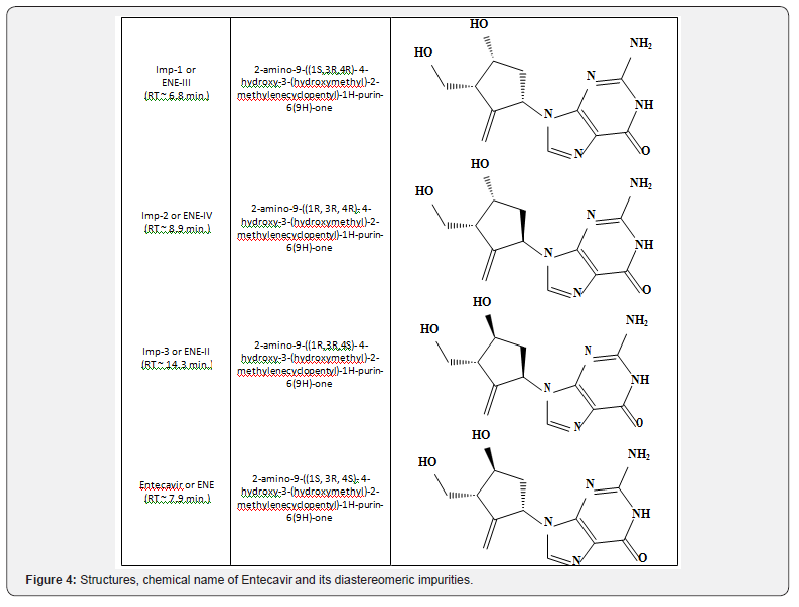
Methods
Chromatographic Conditions: The chromatographic column used for separation was a Zorbax SB-C18, 150 mm, 4.6 mm i.d with 3.5 μm particles. Mix 950 ml of Mill Q water and 50 ml of Acetonitrile is the Mobile phase. The flow rate of the mobile phase was 1.0 ml min-1. The column temperature was maintained at 40°C and the detection was monitored at a wavelength of 254 nm. The injection volume was 20 μL. Mobile phase was used as sample diluent. Preparation of Stock Solutions and System Suitability: Stock solutions of Entecavir standard and sample (500 μg ml- 1) were prepared by dissolving appropriate amounts. Working solutions of 3.75 μg ml-1 were prepared from above stock solutions for diastereomeric impurities determination. A stock solution of diastereomeric impurities at 70 μg ml-1 was also prepared in sample with that of diluent and used as system suitability. Preparation of Sample Solution: An amount of powdered tablets (X-VIR, 0.5 mg) equivalent to the active pharmaceutical ingredient (Entecavir) were transferred to a 100 ml volumetric flask, 30 ml of diluent were added and kept on a rotary shaker for 10 min to disperse the material completely, then sonicated for 10 min and diluted to 100 ml (500 μg ml-1). The resulting solution was centrifuged at 3,000 rpm for 25 min (supernatant solution was used for purity evaluation).
Analytical Method Development: As all the diastereomeric impurities and Entecavir were having UV maxima at around 254 nm, detection at 254 nm was selected for the method development purpose. In order to develop a selective and sensitive method, primary concern during development was to achieve resolution between imp-1, Entecavir, imp-2 and imp-3 peaks and symmetry of the Entecavir peak. When pH moved from basic to acidic, there is no improvement in symmetry of the Entecavir peak was observed. At buffer pH 3.0, tailing of the Entecavir peak was 2.4, resolution between Entecavir and imp-3 was less (Rs < 1) which may be due to the ionization of the amine group in both Entecavir and imp- 3. Upon study at different PHS, improvement in resolution (Rs > 1.8) between imp-1, Entecavir, imp-2 and imp-3 was observed and symmetry of the Entecavir (tailing < 2) peak was obtained. Various ion pairing agents such as Trifluoroacetic acid and Triethylamine were tested to improve peak properties such as peak height, peak symmetry. Addition of 2 ml of Triethyl amine to buffer (0.02 M) at pH 4.5 improved the symmetry of Entecavir (tailing factor was improved to 1.6).
To further improve the symmetry of the Entecavir peak column oven temperature was increased to 40°C. The symmetry of the Entecavir peak was improved to 1.4. The effect of various organic modifiers such as acetonitrile, methanol, and different gradient programs were tried to optimize the retention time of Entecavir and resolution between the impurities. Satisfactory results (retention time of Entecavir was ~ 7.5 min and the resolution between all the impurities was >2.0) were obtained with the above mentioned chromatographic conditions. Buffer pH and % acetonitrile were not played a major role in achieving the separation between diastereomeric impurities and Entecavir. In the optimized conditions Entecavir, imp-1, imp-2 and imp-3 were well separated with a resolution greater than 2.0. Analysis was performed for different batches of bulk drug samples (n = 3) and for pharmaceutical dosage forms (n = 3). Results were within specification. Stability study results as per ICH Q1A (R2) for Entecavir were generated (long term stability 12 months and accelerated stability 6 months) and the results were well within the limits.
Statistical Method: The robustness study were performed using the Minitab 17 software using the 6 as number factors viz., flow, column oven temperature, mobile phase organic ratio, particle size of the packing material, length of the column and wavelength.
Results and Discussion
Analytical Method Validation
The developed chromatographic method was validated for selectivity, linearity, range, precision, accuracy, sensitivity, robustness and system suitability.
Specificity
Specificity of the developed method was assessed by performing forced degradation studies. The specificity of the developed LC method for Entecavir was determined in the presence of diastereomeric impurities namely imp-1, imp-2, imp-3. Forced degradation studies were performed on Entecavir to provide an indication of the stability-indicating property and specificity of the proposed method. All stress decomposition studies were performed at an initial drug concentration of 500 μg ml-1.The chromatograms of blank, system suitability, standard and sample shown in Figures 5-8.




Results of Forced Degradation Studies
Stress studies on Entecavir under different stress conditions (carried out asper ICH Q1B), suggested the following degradation behavior. The drug was exposed to base hydrolysis under reflux conditions. Entecavir showed very slight sensitivity towards the treatment of base hydrolysis. When the drug was exposed to 0.1 N NaOH (24 h reflux at 80°C), minor degradation was observed. The drug was exposed to acid hydrolysis under reflux conditions. Entecavir was not sensitive towards the treatment of acid hydrolysis. When the drug was exposed to 0.1 N HCl (24h reflux at 80°C), no degradation was observed. The drug was exposed to 3% hydrogen peroxide at room temperature for 24 h. Entecavir showed sensitivity towards the treatment of hydrogen peroxide. The drug gradually underwent degradation with time in 3% hydrogen peroxide and major degradation was observed (~87.7%).The drug was exposed to water at 60°C for 24 h. No major degradation products were observed after 24 h.
The drug was stable towards water hydrolysis. The drug was stable to the effect of photolysis. When the drug powder was exposed to light for an overall illumination of 1.2 million lux hours and an integrated near ultraviolet energy of 200-Watt hours/square meter (W/m.hr) (in a photo stability chamber), no degradation was observed. The drug was stable to the effect of temperature. When the drug powder was exposed to dry heat at 60°C for 10 days, no degradation was observed. Similar stress conditions were applied to excipients (lactose monohydrate, microcrystalline cellulose, crospovidone, povidone, and magnesium stearate, titanium dioxide, hypromellose, polyethylene glycol 400, polysorbate 80 (0.5-mg tablet only), and iron oxide red) and drug products injected. There was no interference of stressed excipient samples with Entecavir and its diastereomeric impurities [14-23].
Peak purity results for stressed Entecavir samples, derived from PDA detector, (the purity angle within the purity threshold limit) confirm that Entecavir, imp-1, imp-2 and imp-3peaks were homogeneous and pure. No degradation product peaks were observed after 30 min in the extended run time of 100 min for all the Entecavir stressed samples. Assay studies were carried out for stress samples against qualified reference standard. The mass balance (% assay + % of impurities + % of degradation products) of stressed samples was close to 99.5% confirm the stability indicating power of the developed method. The chromatograms of acid degradation, base degradation, oxidation, photo degradation and thermal degradation shown in Figures 9-13.
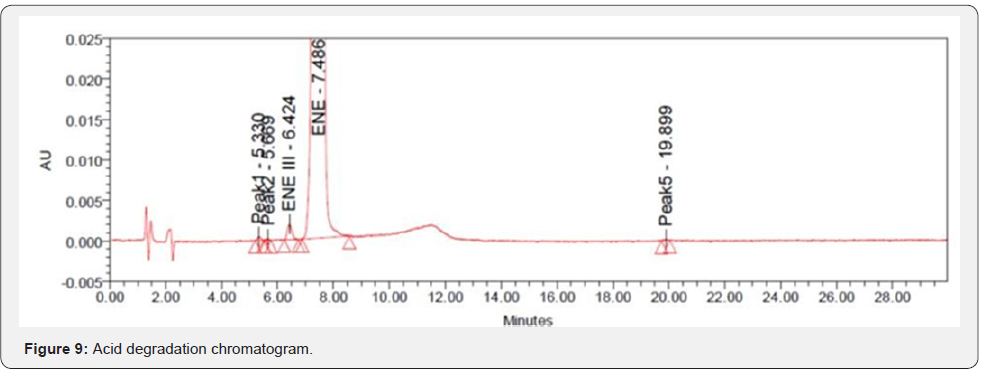

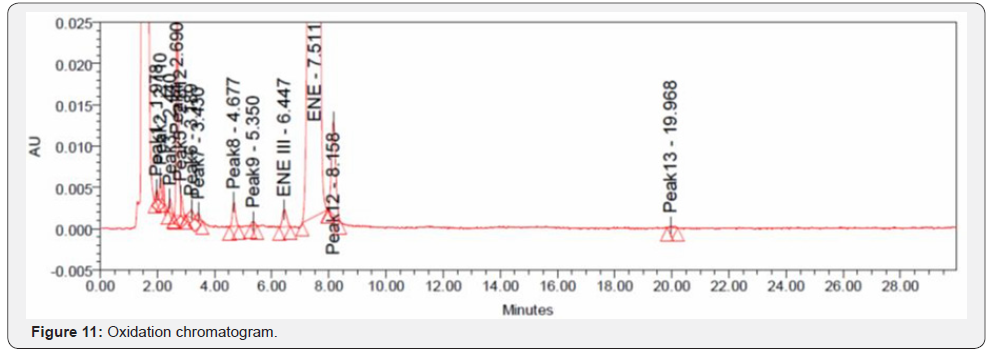
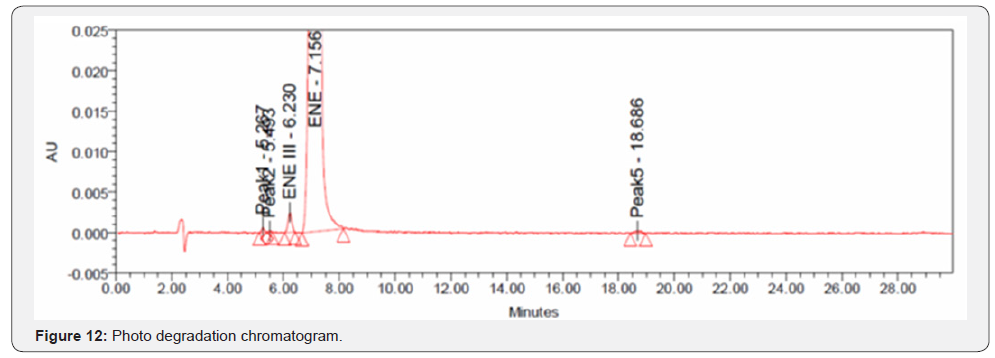

Linearity and Range
Linearity of the method was evaluated by determining nine concentration levels from LOQ to 200% of 500 μg ml-1 analyte concentration. The correlation coefficient obtained for Entecavir was 0.999. The best-fit linear equation obtained for Entecavir was y = 458908x + 1036.13. The correlation coefficient obtained for Imp-1, Imp-2 and Imp-3 were greater than 0.999. The best-fit linear equation obtained for imp-1 was y = 272349x-156.41, for imp-2 was y = 427959x-313.01 and for imp-3 was y = 342134x- 101.08.The results of linearity shown in Tables 2-7. The linearity graphs of Imp-1, Imp-2 and Imp-3 and Entecavir shown in Figures 14-17.
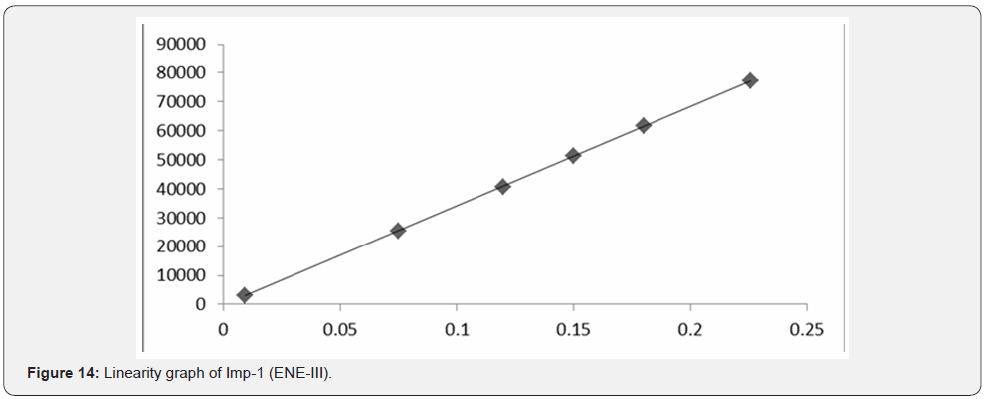
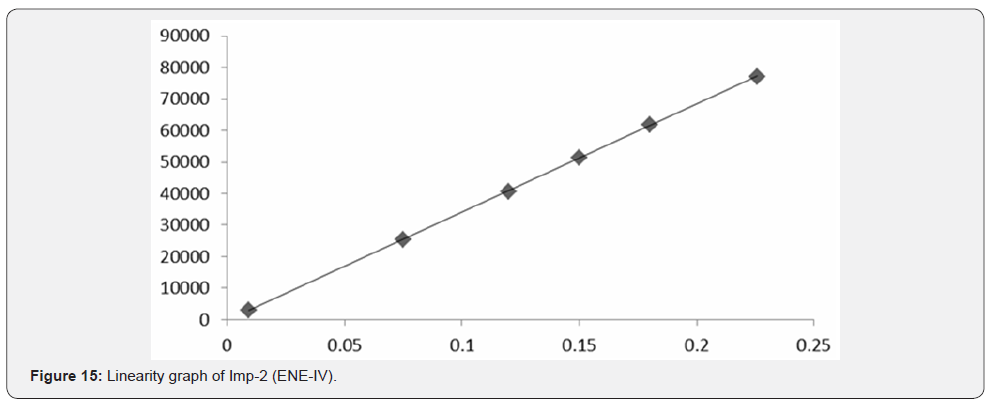
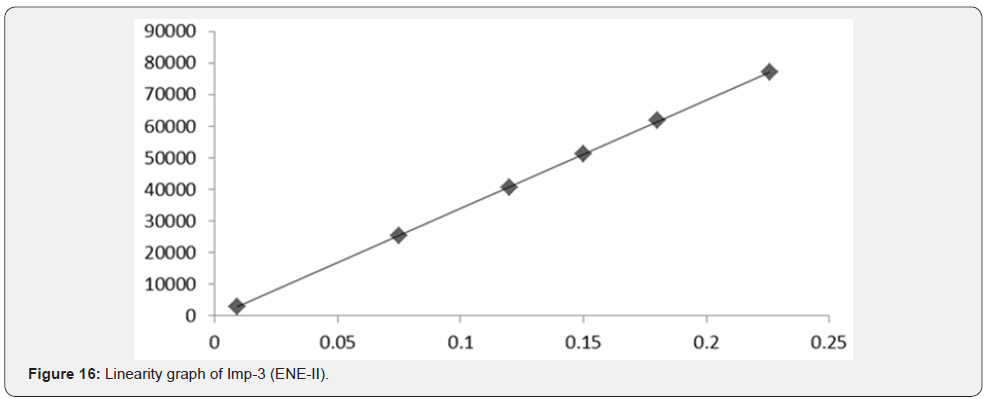


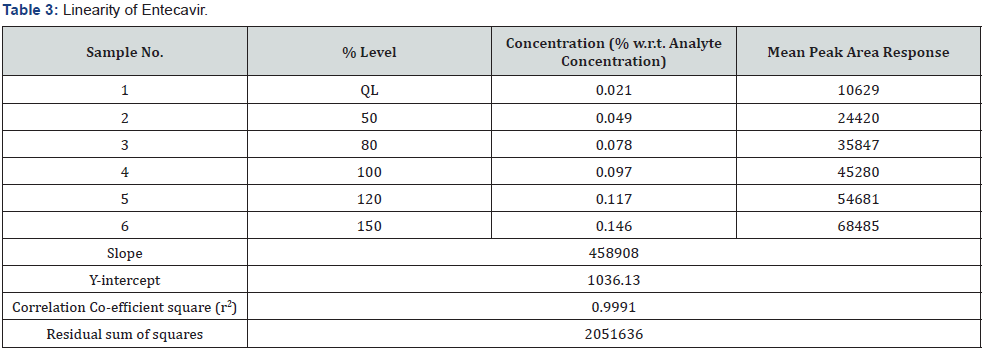
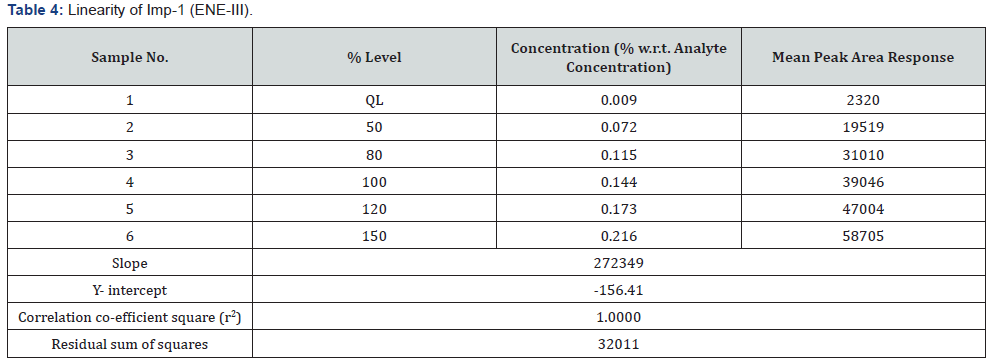
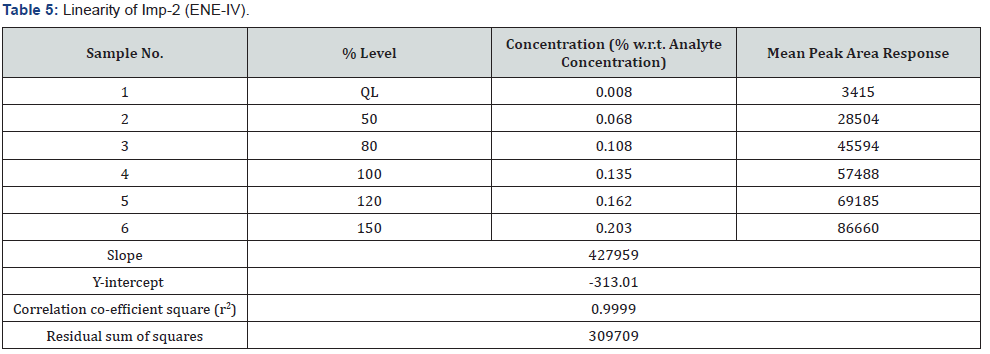
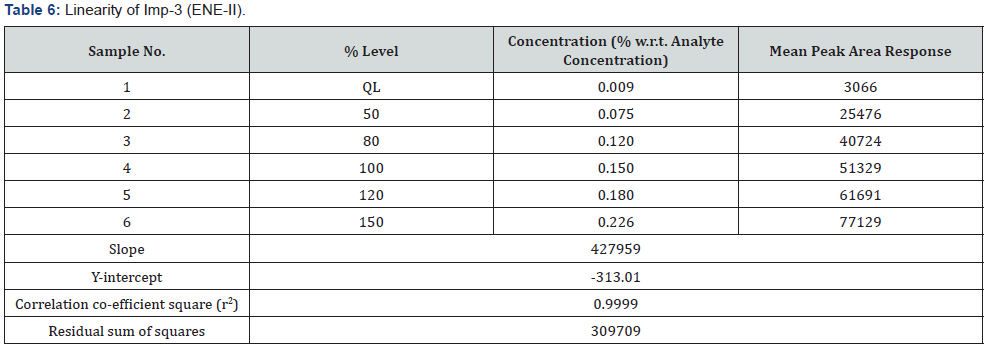
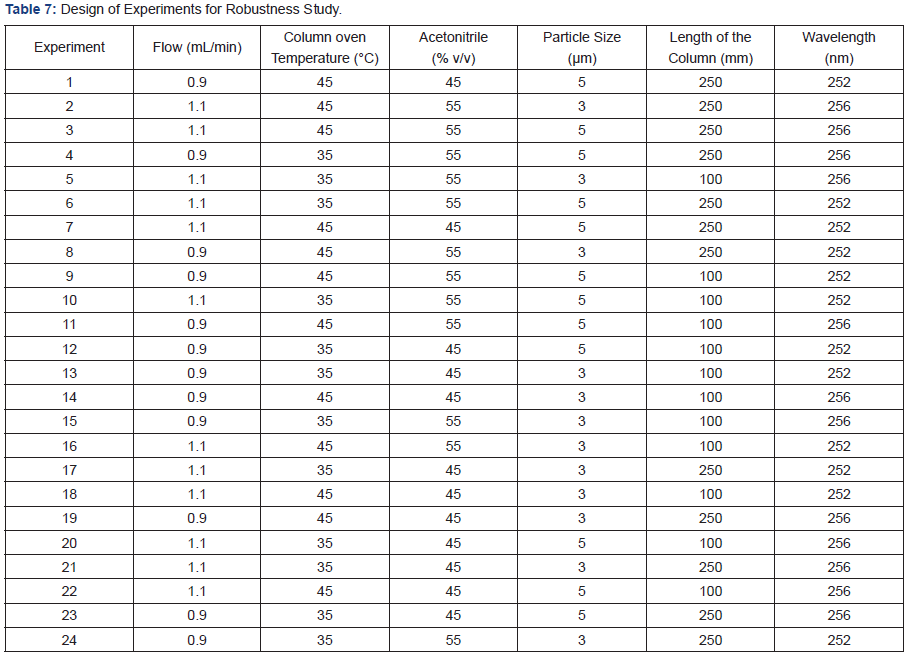
Using the Minitab 17 software with the 6 as number factors-DOE.
Precision
The precision of the diastereomeric impurities was checked by injecting six individual preparations of (3.75 μg ml-1) Entecavir spiked with 0.15% of each impurity. The % RSD for percentage of imp-1, imp-2, imp-3 and Entecavir was below 0.4%. In the intermediate precision, the % RSD for imp was within 0.8%. The intermediate precision of the method was evaluated by different analyst, column and by using different instrument, % RSD’s were within 1.8%, confirming the ruggedness of the method.
Sensitivity
Sensitivity was determined by establishing the LOD and LOQ for imp-1, imp
-2, imp-3 and Entecavir estimated at a signal to-noise ratio of 3:1 and 10:1 respectively, by injecting a series of dilute solutions with known concentration. The limit of detection for imp-1, imp-2, imp-3 and Entecavir were 0.002%, 0.002%, 0.003% and 0.008% for 20 μL injection volume. The limit of quantification for imp-1, imp-2, imp-3 and Entecavir were 0.007%, 0.006%, 0.008% and 0.025% respectively for 20 μL injection volumes. The precision study at the LOQ level performed. The % RSD for the areas of each impurity was within 1.1%. Thus, the method was found to be highly sensitive.
Accuracy
Recovery study was carried out in triplicate at 50, 100 and 150% of the analyte concentration (500 μg ml-1). The percentage of recovery for imp-1, imp-2, imp-3 and Entecavir was 101.3 to 105.1. The percentage recovery of Entecavir in bulk drug samples ranged from 99.2 to 101.5 and in pharmaceutical dosage forms ranged from 98.8 to 101.1%., indicated that the method was suitable for the determination of diastereomeric impurities in drug substances and drug product.
Robustness
The robustness study were performed using the Minitab 17 software using the 6 as number factors viz., flow, column oven temperature, mobile phase organic ratio, particle size of the packing material, length of the column and wavelength. By change in experimental conditions in the Table 2, the resolution between Entecavir, imp-1, imp-2 and imp-3 was evaluated. The flow rate of the mobile phase was 1.0 ml min-1. To study the effect of flow rate on the resolution, 0.1 units changed it from0.9 to 1.1ml min-1. The effect of column temperature on resolution was studied at 35 °C and 45 °C instead of 40 °C. The effect of mobile phase organic ratio, 10% v/v changed it from 45 ml to 55 ml of acetonitrile. The effect of particle size of the packing material, 3.5μ changed it from 3.0μ to 5.0μ. The effect of length of the column, 150 mm changed it from 100 mm to 250 mm. The effect of wavelength of detection, 254 nm changed it from 252 nm to 256 nm. In all the deliberate varied chromatographic conditions carried out (flow rate, column oven temperature, mobile phase organic ratio, particle size of the packing material, length of the column and wavelength of detection), the resolution between closely eluting impurities, namely imp-1, imp-2 peaks and Entecavir, imp-3 was greater than 1.5, illustrating the robustness of the method.
Solution Stability
The solution stability of Entecavir and its diastereomeric impurities was carried out by leaving spiked sample solution in a tightly capped volumetric flask at room temperature for 48 hours. The mobile phase stability was also carried out by freshly prepared sample solutions against freshly prepared reference standard solutions at 48 hours. The %RSD of Entecavir during solution stability and mobile phase stability experiments was within 1.1%. No significant change was observed in the content of imp-1, imp-2 and imp-3 during solution stability and mobile phase stability experiments. The data confirms that standard and sample solutions were stable up to 48 hours.
Numerous methods are available [1-12] for the determination of Entecavir by several techniques like, HPLC, UV, LCMS, etc. All the methods have determined only the LOD, LOQ, % recovery and linearity of Entecavir and not the diastereomeric impurities of Entecavir. The data mentioned in the Table 1 for comparison of different techniques. But the present method describes about the diastereomeric impurities of Entecavir and Entecavir in both bulk drug substances and drug products. All the methods describe the Entecavir as the analyte.
Conclusion
New process of Entecavir well defined in patent EP2488522, one more process was defined by Launch-Pharma Technologies Total Synthesis of Entecavir: A Robust Route for Pilot Production. Once the process efficiency and yield and safe environment robust process established and more synthesis and preparations will be expecting upcoming years. A new, sensitive and stabilityindicating RP-LC method was successfully developed for quantitative determination of diastereomeric impurities of Entecavir in both bulk drug and pharmaceutical dosage forms. The method was found to be accurate and precise with good and consistent recoveries. The validated method may be used for the routine analysis of determination of diastereomeric impurities of Entecavir from bulk drug, pharmaceutical preparation and other quality control samples of product development.
References
- World Health Organization (WHO) (2017) Hepatitis B [Internet]. Geneva: WHO.
- Chae HB, Kim JH, Kim JK, Yim HJ (2009) Current status of liver diseases in Korea: hepatitis B. Korean J Hepatol 15(6): S13-S24.
- Korea Centers for Disease Control & Prevention (2012) Korea National Health and Nutrition Examination Survey. Cheongju (KR): Korea Centers for Disease Control & Prevention.
- Bae SH, Yoon SK, Jang JW (2005) Hepatitis B virus genotype C prevails among chronic carriers of the virus in Korea. J Korean Med Sci 20: 816- 820.
- Kim H, Jee YM, Song BC (2007) Molecular epidemiology of hepatitis B virus (HBV) genotypes and serotypes in patients with chronic HBV infection in Korea. Intervirology 50: 52-57.
- Korean Association for the Study of the Liver (2012) KASL clinical practice guidelines: management of chronic hepatitis B. Clin Mol Hepatol 18: 109-162.
- Pol S, Lampertico P (2012) First-line treatment of chronic hepatitis B with entecavir or tenofovir in ‘real-life’ settings: from clinical trials to clinical practice. J Viral Hepat 19: 377-386.
- Chang TT, Gish RG, de Man R (2006) A comparison of entecavir and lamivudine for HBeAg-positive chronic hepatitis B. N Engl J Med 354: 1001-1010.
- Lai CL, Shouval D, Lok AS (2006) Entecavir versus lamivudine for patients with HBeAg-negative chronic hepatitis B. N Engl J Med 354: 1011-1020.
- Sherman M, Yurdaydin C, Sollano J (2006) Entecavir for treatment of lamivudine-refractory, HBeAg-positive chronic hepatitis B. Gastroenterology 130: 2039-2049.
- Bristol-Myers Squibb Company (2005) Entecavir (BMS-200475): Antiviral Drugs Advisory Committee (AVDAC) briefing document. Silver Spring (MD): Food and Drug Administration
- National Institutes of Health (NIH) (2015) Study of entecavir in patients with chronic hepatitis B virus infection. Bethesda (MD): NIH
- Hou JL, Jia JD, Wei L (2013) Efficacy and safety of entecavir treatment in a heterogeneous CHB population from a ‘real-world’ clinical practice setting in China. J Viral Hepat 20: 811-820.
- Mazzucco CE, Hamatake RK, Colonno RJ, Tenney DJ (2008) Entecavir for treatment of hepatitis B virus displays no in vitro mitochondrial toxicity or DNA polymerase gamma inhibition. Antimicrob Agents Chemother 52: 598-605.
- Liaw YF, Raptopoulou-Gigi M, Cheinquer H (2011) Efficacy and safety of entecavir versus adefovir in chronic hepatitis B patients with hepatic decompensation: a randomized, open-label study. Hepatology 54: 91- 100.
- Shim JH, Lee HC, Kim KM (2010) Efficacy of entecavir in treatment naïve patients with hepatitis B virus-related decompensated cirrhosis. J Hepatol 52: 176-182.
- Zoutendijk R, Reijnders JG, Brown A (2011) Entecavir treatment for chronic hepatitis B: adaptation is not needed for the majority of naive patients with a partial virological response. Hepatology 54: 443- 451.
- Manns MP, Akarca US, Chang TT (2012) Long term safety and tolerability of entecavir in patients with chronic hepatitis B in the rollover study ETV-901. Expert Opin Drug Saf 11: 361-368
- Tenney DJ, Pokornowski KA, Rose RE (2009) 20 Entecavir maintains a high genetic barrier to HBV resistance through 6 years in naive patients. J Hepatol 50: S10
- Tenney DJ, Rose RE, Baldick CJ (2009) Long term monitoring shows hepatitis B virus resistance to entecavir in nucleoside-naive patients is rare through 5 years of therapy. Hepatology 49: 1503-1514.
- Dalmora SL, Sangoi M da S, Nogueira D R, da Silva L M (2010) J AOAC Int 93(2): 523-30.
- Vijay Amirtharaj R, Vinay Kumar Ch, Senthil Kumar N (2011) Int J Res Pharm Biomed Sci 2 (3): 1033-1040.






























